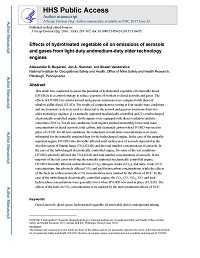Mining Publication: Effects of Hydrotreated Vegetable Oil on Emissions of Aerosols and Gases from Light-Duty and Medium-Duty Older Technology Engines
Original creation date: April 2016
This study was conducted to assess the potential of hydrotreated vegetable oil renewable diesel (HVORD) as a control strategy to reduce exposure of workers to diesel aerosols and gases. The effects of HVORD on criteria aerosol and gaseous emissions were compared with those of ultralow sulfur diesel (ULSD). The results of comprehensive testing at four steady-state conditions and one transient cycle were used to characterize the aerosol and gaseous emissions from two older technology engines: (1) a naturally aspirated mechanically controlled and (2) a turbocharged electronically controlled engine. Both engines were equipped with diesel oxidation catalytic converters (DOCs). For all test conditions, both engines emitted measurably lower total mass concentrations of diesel aerosols, total carbon, and elemental carbon when HVORD was used in place of ULSD. For all test conditions, the reductions in total mass concentrations were more substantial for the naturally aspirated than for the turbocharged engine. In the case of the naturally aspirated engine, HVORD also favorably affected total surface area of aerosols deposited in the alveolar region of human lungs (TSAADAR) and the total number concentrations of aerosols. In the case of the turbocharged electronically controlled engine, for some of the test conditions HVORD adversely affected the TSAADAR and total number concentrations of aerosols. In the majority of the test cases involving the naturally aspirated mechanically controlled engine, HVORD favorably affected carbon dioxide (CO2), nitrogen oxides (NOX), and nitric oxide (NO) concentrations, but adversely affected NO2 and total hydrocarbon concentrations, while the effects of the fuels on carbon monoxide (CO) concentrations were masked by the effects of DOC. In the case of the turbocharged electronically controlled engine, the CO2, CO, NOX, NO, and total hydrocarbon concentrations were generally lower when HVORD was used in place of ULSD. The effects of the fuels on NO2 concentrations were masked by the more prominent effects of DOC.
Authors: AD Bugarski, JA Hummer, SE Vanderslice
Peer Reviewed Journal Article - April 2016
NIOSHTIC2 Number: 20047021
J Occup Environ Hyg 2016 Apr; 13(4):297-306
See Also
- Characterization of Nanometer and Ultrafine Diesel Aerosols in the Underground Mining Environment
- Comparing Measurements of Carbon in Diesel Exhaust Aerosols Using the Aethalometer, NIOSH Method 5040, and SMPS
- Control Technologies and Strategies for Reducing Exposure of Underground Miners to Diesel Emissions
- Diesel Aerosols and Gases in Underground Metal and Nonmetal Mines
- Diesel Aerosols and Gases in Underground Mines: Guide to Exposure Assessment and Control
- Effects of Diesel Exhaust Aftertreatment Devices on Concentrations and Size Distribution of Aerosols in Underground Mine Air
- Effects of Sintered Metal Diesel Particulate Filter System on Diesel Aerosols and Nitric Oxides in Mine Air
- Examination of Diesel Aftertreatment Systems at NIOSH Lake Lynn Laboratory
- Technology News 514 - The Air Quantity Estimator (AQE): A New Computer Software Tool for Large-opening Mine Ventilation Planning
- Toward developing a new occupational exposure metric approach for characterization of diesel aerosols
- Content source: National Institute for Occupational Safety and Health, Mining Program


 ShareCompartir
ShareCompartir
